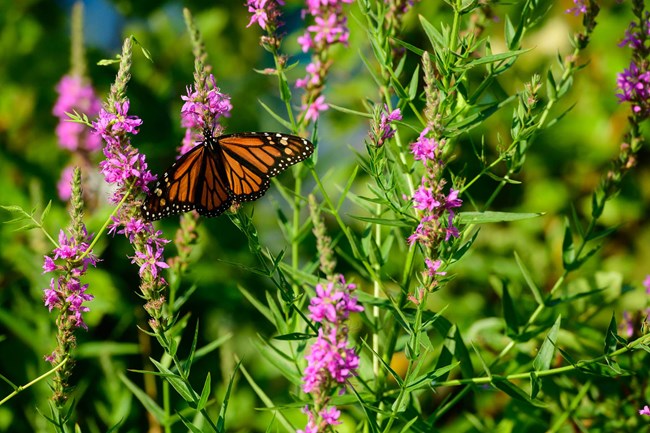Last updated: December 22, 2021
Article
Pollinators and Climate Change

NPS Photo / Graphic by 4C
Pollinators play a vital role in plant reproduction, making them fundamental to supporting healthy ecosystems. In a symbiotic manner, while pollinators help to spread the pollen of plants and allow them to reproduce, plants reward pollinators with nectar. Humans also rely on pollinators for survival, as we rely on plants as a food source and in medicines.
The changing climate impacts pollinators by shifting growing and blooming seasons and potentially weakening the plant populations that pollinators depend on. Additionally, warmer temperatures have altered migration patterns, affecting pollinator species like butterflies.
Check out some of the iconic pollinators you can find at Kenilworth Park and Aquatic Gardens through this Day vs. Night Pollinators poster.
The Monarch Butterfly Story

NPS photo by Tim Ervin
The Monarch butterfly is a pollinator species with an enormous impact on maintaining the health of the ecosystem. It is a yearly visitor to the Kenilworth Park and Aquatic Gardens. In addition to pollinating many plant species, Monarchs are a food source to other wildlife like birds and insects.
However, the Eastern Monarch butterfly population has declined by 80% from 2000–2020 causing concern. This decline has led to considerations of putting the Monarch on the Endangered Species List.
Decline of Milkweed
Milkweed is the only plant genus on which Monarch caterpillars feed. The milkweed plants support Monarch larvae, caterpillars, and adults as an essential part of their diet. Declines in Milkweed plants have led to declines in Monarch butterfly populations.
Milkweed is negatively affected by deforestation, the use of pesticides and herbicides, and the changing climate. Climate change can accelerate the spread of invasive species like the Purple Loosestrife, an invasive plant that looks very similar to the milkweed. The spread of Purple Loosestrife has injured the Monarch butterfly population, as butterflies mistake the Purple Loosestrife as milkweed and lay their eggs on it.

NPS / 4C park illustration
Muddled Monarch Migration
Monarch biology is sensitive to temperature as they rely on temperature changes to signal the beginning of their lengthy migration. If Monarchs migrate too early in the spring, the milkweed will not have had enough time to mature and the Monarchs will be left with nowhere to lay their eggs. In the fall, when there is an abundance of milkweed and warm temperatures, Monarchs are prevented from departing for their overwintering grounds.
Further impacts of climate change, such as extreme weather events like tropical storms and hurricanes, damage milkweed and Monarch populations—placing the iconic butterflies at even greater risk.
How to Help Pollinators
- Avoid Pesticides and Herbicides: Pesticides and herbicides can injure unintended species like pollinators and the plants that pollinators depend on for survival. By choosing to avoid these chemicals, humans can ensure that ecosystems are safe and healthy.
- Compost and Recycle Your Trash: Composting food and organic items helps to create healthy soil that supports plant growth. Recycling trash is another way to aid plant productivity and it protects pollinators, too!
- Plant a Pollinator Garden: Planting a garden is a fantastic way to attract pollinator species and provide food and shelter for other wildlife. Aim to select native plant species in order to preserve and encourage biodiversity.
- Have Conversations with Friends and Family: Spreading awareness and sharing knowledge is a great way to help pollinators! Others may have tips and creative ways to aid pollinator activity.
- Volunteer with Local Organizations: Many different groups have made dedicated efforts to clean up communities and develop environments which are healthy habitats for pollinators. This may include trash pick-ups or tree planting events. Planting trees and other plants has additional ecosystem benefits, such as removing CO2 from the atmosphere and supporting hundreds of pollinator species.

